For those who love the work of Giampaolo Bertozzi (Borgo Tossignano, 1957) and Stefano Dal Monte Casoni (Lugo di Romagna, 1961 -2023), Tranche de vie, a widespread exhibition currently underway in Imola in the three public museums (San Domenico, Palazzo Tozzoni, Rocca Sforzesca) curated by Diego Galizzi, is an essential stop.
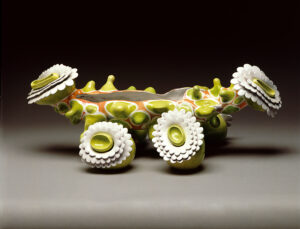
Bertozzi & Casoni, Go-Go, 1989, painted majolica, courtesy Imola Musei
On the ground floor of the San Domenico Museum quadriportico In nuce.1980-1997 develops, that is, the story of what can be defined as the origin of the story of the Romagna duo of ceramists, who met at the State Institute of Ceramic Art in Faenza and then continued their training at the Academy of Fine Arts in Bologna and founded the Bertozzi & Casoni company in Imola in the 1980s. In the large corridor around the cloister, the visitor has the opportunity to admire around sixty ceramic pieces, grouped together for the first time: colorful majolica theatres, surrealist dancers, palm trees, phytomorphic details inspired by Bosch’s Garden of Earthly Delights, objects which seem to have come out of illustrated children’s books (Zoccolo Orange, Scattino Orange, fantastic machines like Dormigliona, a funny elongated seat on wheels) or from Luzzati’s stories (Reuccio, Korona). They are often influenced by the world of design (vases, trays, tea services): in fact, the collaboration with the International Center for Studies and Experimentation on Ceramics in synergy with Cooperativa Ceramica di Imola dates back to 1984; an adventure that allowed them to establish relationships and collaborations with designers and artists such as Gio Ponti, Ugo La Pietra, Alessandro Mendini, Jan Knap, Arman. Curious, fairy-tale, redundant works, in search of or preparatory to a style that would then lead to their unmistakable and distinctive “manner”.

Bertozzi & Casoni, Dormigliona, 1991, semi-refractory enamelled and painted, iron, 95 x 240 x 75 cm, courtesy Imola Musei
Bridge sculpture, ferrying from the period widely documented here (i.e. “Bertozzi e Casoni before Bertozzi & Casoni,”) to their best-known phase (synthesized as “contemplation of the present”, “epic of trash” reflection on the theme of vanitas) is the imposing Madonna of Choose Paradise (1997), included in the permanent collections of the museum, portrayed while cutting a flowery meadow that invades her cloak with a lawnmower, in a symbolic circularity that immediately evokes that of life and death. A perfect synthesis of the poetics underlying the discourse carried out by the artists explained in the works exhibited on the ground floor and donated, together with the aforementioned work, to the city’s public collections: Nothing is as it appears (2018), a wall installation with multiple symbolic meanings composed of three mirrors (plain, concave and convex) from which emerges a skeletal head of Pinocchio surmounted by colored parrots trying to mirror themselves (the reference to De Dominicis, Kounellis and Pistoletto is evident), and a series of still lifes evoking the memento mori (trays with broken eggs, rubbish bins and snails).
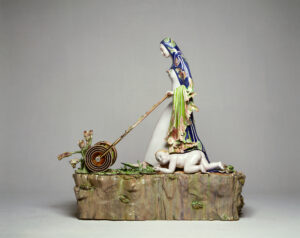
Bertozzi & Casoni, Scegli il paradiso, 1997, polychrome ceramic, 196 h. cm, photo Bernardo Ricci, courtesy Imola Musei
In the historic spaces of the sumptuous Palazzo Tozzoni, donated in 1973 to the Municipality together with the furnishings by the last descendant of the family, Tranche de vie comes to life, that is, what can be considered the heart of a varied and mysterious mise en abyme played on displacement and re-actualization of the life of the counts themselves, defined as a “large choral installation, a true laboratory of doubt”. An immersion in the world of internationally renowned ceramic artists who have made this medium, mostly used in the artisan sector, a privileged medium for their hyper-realistic artistic creations full of high cultural references (from Warhol to De Dominicis, from Arcimboldo to Morandi, from Fontana to Kounellis) and pop, taken from common life, balanced between tradition and innovation.
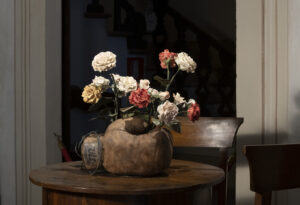
Bertozzi & Casoni, Preghiera, 2022, polychrome ceramic, photo Nazario Spadoni, courtesy Imola Musei
At the beginning of the tour, we find the famous macaque climbing the wall and stealing the canvas of Vermeer’s The Girl with a Pearl Earring, while in the bedroom, among the Empire-style furnishings left intact, the visitor is welcomed by a disorienting and not very graceful life-size monkey, dressed like Mademoiselle Caroline Rivière in the nineteenth-century portrait painted by Jean-Auguste-Dominique Ingres to which it is probably an ironic homage. There is no shortage of iconic still lifes scattered here and there on eighteenth-century furnishing objects: flowers on which beetles, chameleons and ladybugs rest which make it “alive”, little flowers inside the vintage Paulista coffee can, flowers peeking out from a glove boxing in a dichotomous Prayer (2022), collected inside refined vases, bouquets that pay homage to Morandi, or that bloom wonderful and pure despite being planted in clods strewn with waste and crumpled banknotes. And then waste, piles of messy objects, on which lie scattered cigarette butts and pills, dirty cups, chicken scraps inside a bowl, reminding us of pop vanitas, something that “has been”, because after all, as the artists, even landfills have an undeniable charm in them, smell aside.
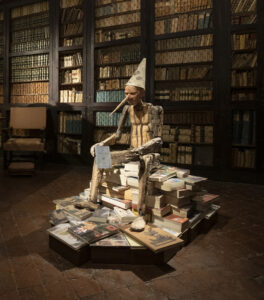
Bertozzi & Casoni, Non ricordo, 2014, polychrome ceramic, photo Nazario Spadoni, courtesy Imola Musei
In the library between fake and real books, we find I don’t remember (2015) the aged Pinocchio of Collodian memory, the personification of lies “just like art which does not give answers but generates continuous questions”; in the dining room there is a chaotic table “cleared” in a reinterpretation of Spoerri or rather, as the artists suggest, a quote from the sixteenth-century Bernard Palissy. The decapitated deer on a circular Renaissance grotesque (Dove Come Quando, 2014), dedicated to the myth of Actaeon, emerges disturbingly from the open doors in the sitting room; instead of the stage it incorporated flowering peach branches, a message of continuation of life in spite of everything. Resting on bright golden paper spread out on a Persian carpet, a milk egg hosts a not very sweet surprise, that of the skeleton of a small animal with the appearance of a jewel. Once again the work is ironic and profound and suggests that things are perhaps not always as they appear or that they condense both one aspect and its opposite in itself. And then the Warhol Brillo cartoons, original kennels for English setters and parrots, the First Aid box dedicated to contemporary man and the pain he feels during his existence softened by Art, a thoughtful death in steel with a scythe resting on its side and the telephone book open in front while a parrot, which seems to have just returned from the installation that Kounellis carried out in the 1960s at Sargentini’s gallery L’Attico, stares at it imperturbably from a table full of lovable remains (Reflections on death, 2008). In the kitchen spaces, a funny but also dangerous little monkey with a basket of fruit, together with a knife, pencil and hand grenade, shows us a small canvas with a cut by Fontana; a little further on, a supermarket bag abandoned on an imposing wooden table on which large snails slide lets us understand that that usual object has been overwhelmed by an unexpected event.
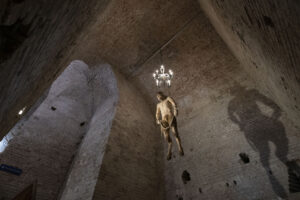
Bertozzi & Casoni, La Morte dell’eros, 2023, polychrome ceramic, photo Nazario Spadoni, courtesy Imola Musei
Finally, located in the south-east tower of the Castle, in a bare corner of the Rocca Sforzesca, with exposed bricks, we find the Death of Eros, a polychrome ceramic sculpture three and a half meters high which represents the God Pan hanged on a precious Capodimonte chandelier. The faun, symbol of vitality and erotic drive, presents itself to the spectator in its tragic impact, almost as if it were the last swan song, a bitter awareness of an inexorably lost golden age. The recently created work was commissioned by Bertozzi, after the death of Stefano Dal Monte Casoni. Conceived by the latter, it had a long gestation of 23 years before being completed and exhibited to the public. Disturbing, it leaves you speechless, especially because he is a God who dies together with the metaphor of everything he represents. But in the universe of Bertozzi & Casoni things are not always as they appear…
Tristana Chinni
Info:
Bertozzi & Casoni. Tranche de vie
28/10/2023 – 18/02/2024
curated by Diego Galizzi
Exhibition project spread across the three public museums in Imola
Section #1: “Tranche de vie” (Palazzo Tozzoni)
Section #2: “In nuce. 1980-1997” (Museo San Domenico)
Section #3: “La morte dell’eros” (Rocca Sforzesca)
Organization: Città di Imola / Imola Musei
Main partner: Cooperativa Ceramica di Imola- Patronages: Ministero della Cultura, Regione Emilia-Romagna; EPCF – European Parliament Ceramics Forum
With the contribution of: Fondazione Cassa di Risparmio di Imola, con il supporto di: Con.Ami; Confartigianato Bologna Metropolitana; Hera S.p.A.- Media partner: Finestre sull’Arte
musei@comune.imola.bo.it- www.imolamusei.it
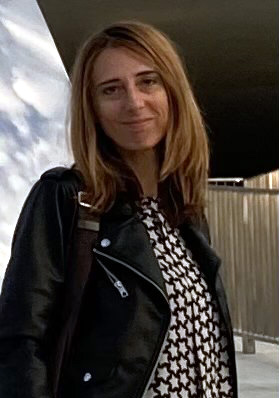
After classical studies, she enrolled at the Faculty of Letters and Philosophy in Bologna, graduating in History of Cinema (DAMS) and later in Art History. She obtained a Master in Communication for cultural enterprises. Journalist and critic, she collaborates with various print and online magazines specialized in the artistic and cultural sector, including Finestre sull’Arte, Segno, Exibart, Zeta-International magazine of poems and research, Punto e Linea Magazine, Gagarin Orbite Culturali. She loves art in all its forms, preferring modern, contemporary and research.






NO COMMENT